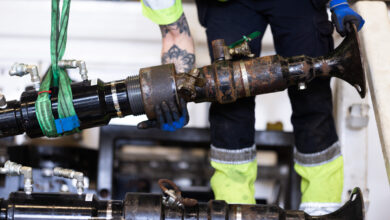Nine’s dissolvable plug carbon footprint up to 91% smaller per wellbore than conventional composite plug
Nine Energy Service has announced a recently completed third party report which found the life cycle carbon footprint of the company’s dissolvable frac plug to be up to 91% smaller per wellbore than that of a conventional composite. The study, conducted by Environmental Resources Management (ERM), indicates that operators can recognize a significant reduction in greenhouse gas emissions by using dissolvable plugs and avoiding the need for drill-out.
The report found the dissolvable plug’s footprint without clean-out per wellbore was 6,873 kg CO2 equivalent (CO2e), compared with the conventional composite plug’s footprint of 74,146 kg CO2e. This is a 67.3 metric ton CO2e reduction per wellbore, which equates to the emissions of 14 passenger cars driving for one year. Even with clean-out, the data showed Nine’s dissolvable plug carbon footprint was 18% smaller than a conventional composite per wellbore, with the dissolvable’s footprint being 60,843 kg CO2e. This equates to 13.3 fewer metric tons of CO2e, per wellbore or 3 passenger cars driving for one year, when compared with composites.
The ERM study compared a typical deployment of 70 plugs per wellbore in the Permian Basin. The study period observed normal production periods without peaks to ensure homogeneous operational data.
As lateral lengths increase and plug drill-outs become more difficult, risky and time-consuming, operators can reduce both risk and expenditures by avoiding drill-outs altogether. With a 91% improvement in life cycle carbon footprint over composites, dissolvable technology allows operators to maximize production while significantly mitigating environmental impact. The ERM study demonstrates that dissolvable plugs lower carbon emission intensity in a scalable way, which can be applied on a per-wellbore basis.
“This study from ERM highlights the value that dissolvable plug technology can offer, in terms of being better for the environment and more sustainable when compared with traditional composites,” Ann Fox, President and CEO, Nine Energy Service, said. “We already know dissolvable plugs reduce upfront D&C costs and provide multiple points of uplift in many cases to IRR due to efficiencies in bringing production to market faster. These results demonstrate another important benefit — the greenhouse gas emissions reduction that organizations can achieve as part of efforts to improve sustainability.”
“This rigorous carbon footprint assessment using the ISO 14067 approach clearly showed the reduced impact of a dissolvable plug deployment versus a composite plug over the complete life cycle of the product, from the extraction and manufacturing of the product components through usage and final disposal,” Michael Grossner, Principal Consultant, ERM, said.




